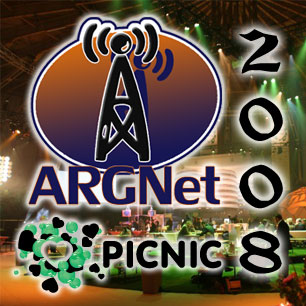 Editor’s Note: Daniël van Gool, an administrator at the Unfiction forums, was on the scene at PICNIC ’08 on behalf of ARGNet. We were impressed with Daniël’s work covering PICNIC ’07 and, as media partners of the annual cross-media festival, were invited to a number of special events in addition to the speaker sessions. This is the second part of Daniël’s comprehensive look at this year’s event, still focused on the first day of conference speakers (the first part is here). All pictures are courtesy of Daniël as well.
Editor’s Note: Daniël van Gool, an administrator at the Unfiction forums, was on the scene at PICNIC ’08 on behalf of ARGNet. We were impressed with Daniël’s work covering PICNIC ’07 and, as media partners of the annual cross-media festival, were invited to a number of special events in addition to the speaker sessions. This is the second part of Daniël’s comprehensive look at this year’s event, still focused on the first day of conference speakers (the first part is here). All pictures are courtesy of Daniël as well.
Next up was Aaron Koblin, a software developer and artist who works for Google’s Creative Labs and whose work is internationally renowned. He specializes in data visualization, which was another recurring theme through PICNIC’08.
There’s a revolution going on in data visualization, departing from pie-charts and graphs and taking on quite a different, creative route. It took a while for me to figure out why this topic, while interesting, was featured so prominently at a conference like PICNIC, but the theme became apparent after several speakers made it clear that one of the biggest trends on the internet nowadays is the connection between the digital and the physical worlds. Manipulating “virtual objects” online is a thing of the past: interacting with real objects and real data and input from the real world is what’s becoming big. And this is why data visualization is rapidly becoming a hot topic.
Koblin showed us several examples of interesting ways to portray data, including a display of oil production in the form of oil blobs crawling on a map and a very cool graphical representation which illustrated which portions of New York City were communicating via email with recipients around the world. I could write about these demonstrations for a long time, but I realize that, apart from hardly being interesting, they do Koblin’s work no justice, so if you’re interested, visit his website and check out some of his work.
He later made the connection between his line of work and creative collaboration by telling the audience about his project “The Sheep Market”. Basically, he was inspired by Amazon’s service Mechanical Turk, a platform used to crowdsource rather simple and often repetitive tasks that you cannot presently have a computer do for you, such as transcription of text or identifying products with damaged barcodes. Koblin jokingly called this “Artificial Artificial Intelligence”.
His idea was to create a work of art through Mechanical Turk by giving the users a less mundane task, namely “draw a sheep facing left”, and paying them two cents per task for their services. This resulted in The Sheep Market (http://www.thesheepmarket.com/), a website displaying and selling both the drawings and the animations of people drawing the sheep. That last part is especially interesting, since it lets you see the effort people did or did not put into completing this two cent task.
Some data: 10,000 sheep were drawn, the users drawing the sheep came from 7,599 unique ip’s, and only one person submitted written text (“why, why are you doing this??”).
Koblin’s motivation for choosing sheep: apart from a sheep being an internationally recognized symbol for ‘follower’, the idea sprang from the French children’s story, Le Petit Prince. In the tale, one of the characters asked another to draw a sheep, and while he kept trying to draw a sheep, he was never satisfied with the result. In the end, he ended up drawing a box saying, “the sheep is in the box, use your imagination.”
An even more ambitious and similar project that followed was 10,000 cents: a 100 dollar bill was divided into 10,000 pieces (a cent, in monetary terms), and each piece was put on Mechanical Turk with the request to reproduce it in drawing, for a reward of one cent. When 10,000 contributions were submitted, it had cost exactly 100 dollars to reproduce a $100 bill. The result can be seen at the project’s website along with the animation of each separate piece. Interesting to note: at the site, you can also take a closer look to some of the more… rebellious contributions.
Koblin went on to talk for a bit on his work on the Radiohead music video “House of Cards”, which was put together by digitizing the band members in various settings. At Koblin’s website is a portion dedicated to that video which allows visitors to manipulate aspects of the video.
